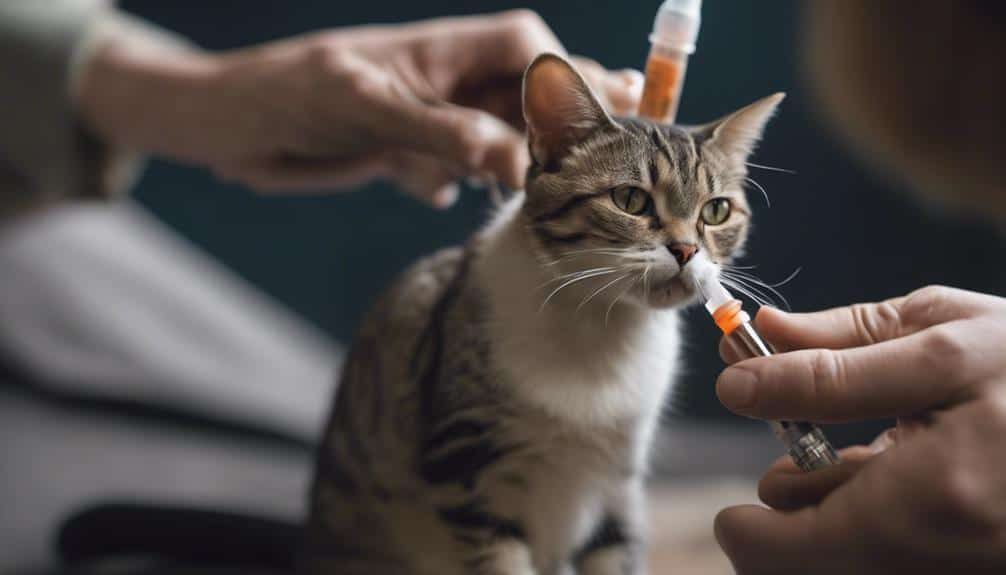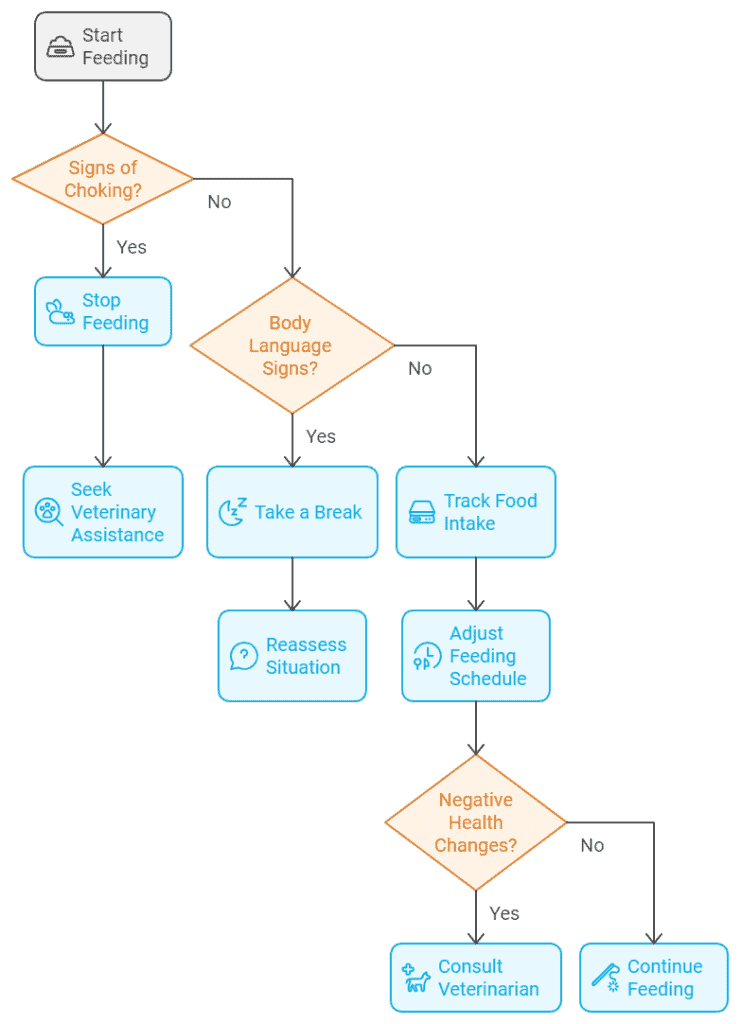The Best Fluffy Pancakes recipe you will fall in love with. Full of tips and tricks to help you make the best pancakes.

Feeding your cat using a syringe may seem like a daunting task, but with the right guidance, it can become a seamless part of your routine. Mastering this skill is crucial for ensuring your cat’s well-being during times of illness or frailty.
By following a step-by-step approach, you will not only provide essential nutrition to your feline companion but also build a stronger bond through this act of caregiving. Get ready to equip yourself with the knowledge and skills needed to confidently assist your cat in their road to recovery.
Key Takeaways
- Select appropriate syringe size and high-calorie food for safe and efficient feeding.
- Administer food slowly, monitor reactions, and prioritize your cat’s well-being during syringe feeding.
- Watch for distress signs, adjust portions as needed, and consult a vet for guidance on nutrition.
- Ensure cleanliness, controlled portions, and a smooth feeding process for your cat’s health and recovery.
Reasons for Syringe Feeding a Cat
When considering the reasons for syringe feeding your cat, it’s essential to understand the critical situations that may necessitate this specialized form of feeding. Cats may require syringe feeding when they’re unable to eat due to various reasons such as recovery from surgery, illness, dental problems, or chronic illnesses like kidney disease or diabetes.

Age-related decline in eating ability can also lead to significant weight loss and lethargy, making syringe feeding necessary. Signs like refusal to eat or drink, vomiting after meals, and malnutrition indicate that your cat may benefit from high-calorie, essential nutrient-filled cat food administered through syringe feeding.
This method not only provides hydration but also aids in preventing malnutrition and dehydration. It’s crucial to consult your veterinarian for guidance on the right food and technique to ensure your cat receives the necessary nutrients for recovery and overall well-being.
Choosing the Right Syringe and Food
When selecting a syringe for feeding your cat, opt for a 5-10 ml oral feeding syringe with smooth plunger movement and clear measurement markings.
Choose high-calorie, soupy cat food that can easily pass through the syringe tip for efficient feeding.
Look for a syringe with a catheter or curved tip to ensure safe and effective administration without causing harm to your cat.
Syringe Size Selection
For precise and controlled food administration during syringe feeding your cat, opt for a 10 ml syringe to ensure accurate dosing and minimize the risk of aspiration. When choosing the right syringe size for feeding your cat, it’s crucial to consider their comfort and safety. Here is a helpful table to guide you in selecting the appropriate syringe for your feline friend:
| Syringe Size (ml) | Suitable for Cats |
|---|---|
| 1 ml | Small cats or kittens |
| 3 ml | Medium-sized cats |
| 5 ml | Large cats |
| 10 ml | Recommended for accurate dosing and control |
| 20 ml | Not recommended due to the risk of aspiration |
Selecting the correct syringe size can make feeding your cat a smoother and safer process.
Suitable Food Consistency
To ensure successful syringe feeding for your cat, focus on achieving the ideal food consistency by selecting the appropriate syringe size and preparing a smooth blend of liquid cat food or watered-down pate. Choose a smaller syringe size, like a 10 ml, to prevent aspiration and enable precise feeding in small amounts.
Opt for liquid cat food suggested by the vet or create a mixture by blending pate cat food with water until it reaches a smooth consistency suitable for syringe feeding. Utilize a blender to ensure the food is easy to administer through the syringe.
Remember to administer any necessary medications before syringe feeding to ensure your cat gets all required treatments. For specific dietary needs, seek advice from your veterinarian to enhance your cat’s health through syringe feeding.
Preparing Necessary Supplies
Gather the necessary supplies for syringe feeding your cat, including oral feeding syringes, high-calorie, soupy cat food, a towel, and choose a comfortable feeding location. Here are some essential tips for preparing the supplies:
- Use a 10 ml Syringe: Opt for a 10 ml syringe for feeding to ensure controlled portions and prevent aspiration. This size is suitable for most feeding needs and allows for precise measurements.
- Choose the Right Consistency: Select a high-calorie, soupy cat food that’s easy to draw into the syringe and feed smoothly. The right consistency will make syringe feeding more manageable for both you and your cat.
- Ensure Cleanliness: Maintain proper hygiene by washing your hands, syringes, and feeding dishes thoroughly before each feeding session. This practice helps prevent infections and ensures a safe feeding environment for your cat.
Establishing a Feeding Routine
After preparing the necessary supplies for syringe feeding your cat, the next crucial step is to establish a consistent feeding routine. Setting a feeding schedule helps your cat adjust to the syringe feeding process.
It’s essential to monitor your cat’s response closely during feeding sessions to ensure they’re adapting well. Create a quiet environment free from distractions to reduce stress and anxiety for your cat. Using positive reinforcement and gentle handling techniques can make the feeding experience more comfortable for your feline friend.
Keep a feeding diary to track your cat’s progress, noting the amount of food consumed and any changes in appetite or behavior. Consistency is key in establishing a feeding routine that works for both you and your cat.
With patience and a structured approach, your cat will likely adjust well to the syringe feeding process.
Positioning Your Cat Correctly
To position your cat correctly for syringe feeding, ensure they’re sitting comfortably and securely to avoid escape.
Elevate the cat’s head slightly to aid in swallowing and prevent choking.
Use secure restraint methods like wrapping them in a towel to maintain control during the feeding process.
Proper Sitting Position
Position your cat on a non-slip surface to ensure stability during feeding and prevent any sliding.
To position yourself correctly:
- Sit on the floor or a low stool at eye level with your cat for better control.
- Keep your cat’s body close to yours to create a secure and comfortable feeding environment.
- Use a towel or blanket to wrap your cat gently for stability and to reduce stress.
Cat’s Head Elevation
For optimal feeding success, ensure your cat’s head is gently elevated to facilitate swallowing and prevent choking during syringe feeding.
Positioning your cat with a slightly elevated head can aid in the feeding process by helping the food travel down the esophagus correctly.
It’s important to avoid over-elevating the head, as this may cause discomfort or difficulty in swallowing for your cat.
Correct positioning of the cat’s head is crucial to make the syringe feeding process more comfortable and effective for both you and your feline friend.

Secure Restraint Methods
Elevating your cat’s head properly is essential for safe and effective syringe feeding. Now let’s focus on securing them with the right restraint methods. To position your cat correctly, consider the following:
- Wrap Your Cat in a Towel: Use a towel to secure your cat and prevent unnecessary movements during feeding sessions. This method can help create a sense of comfort and control for your feline friend.
- Create a ‘Kitty Burrito’: Wrapping your cat in a towel like a burrito can provide additional stability and prevent them from wriggling away, ensuring a more successful feeding experience.
- Utilize Zygomatic Arches: Hold your cat’s head gently by the zygomatic arches, often referred to as ‘kitty handles,’ to stabilize their head and facilitate the feeding process while reducing the risk of injuries.
Administering the Food Slowly
To ensure the safe and effective syringe feeding of your cat, it’s crucial to administer the food slowly. Making sure to control the flow of food is essential to help your cat swallow without any issues. By assisting the feed with your hand, you can regulate the amount of food entering your cat’s mouth, ensuring it’s just enough for them to handle comfortably. This slow feeding method reduces the risks of choking or gagging, allowing your cat to swallow properly and decreasing the chances of aspiration.
Feeding slowly also gives your cat’s digestive system enough time to process the food effectively. Being patient during this process can make it more successful and less stressful for your cat. Remember, the goal is to provide nourishment while keeping your feline companion safe and comfortable. By administering the food slowly, you prioritize your cat’s well-being and make the syringe feeding experience as smooth as possible.
Monitoring Your Cat’s Reaction
After administering the food slowly to your cat, it’s crucial to closely monitor their reaction during the feeding process for any signs of distress or discomfort. Here are three essential steps to effectively monitor your cat’s reaction:
- Watch for Signs of Choking: Keep a close eye on your cat for any signs of choking or difficulty swallowing, such as excessive drooling or coughing. If you notice these signs, stop feeding immediately and seek veterinary assistance.
- Monitor Body Language: Pay attention to your cat’s body language for any signs of discomfort or stress during feeding. If your cat seems uneasy or exhibits signs of distress, take a break and assess the situation before continuing.
- Track Food Intake: Keep track of the amount of food consumed to ensure your cat is getting enough nutrition. Adjust the feeding schedule or portion sizes accordingly to meet your cat’s needs. If you notice any negative changes in weight, energy levels, or overall health, consult with a veterinarian for further guidance.

Frequently Asked Questions
How Much Should I Syringe Feed My Cat at a Time?
When syringe feeding your cat, start with small amounts to avoid overwhelming them. Offer frequent feedings divided throughout the day. Adjust portions gradually based on their tolerance and appetite. Consult your vet for personalized guidance.
What Size Syringe for Feeding Cats?
For feeding cats, a 10 ml syringe is generally recommended. Using small syringes aids in precise feeding, reducing choking risks. Consult your vet for guidance on syringe size tailored to your cat’s needs, ensuring safe and controlled feeding.
How Long Can a Cat Go Without Eating?
You should monitor your cat closely if they go without eating for more than 24 hours. Cats with health issues may need food sooner. Lack of eating can cause serious problems like fatty liver disease. Consulting a vet is crucial.
Why Does My Cat Act Hungry but Won’t Eat?
When your cat seems hungry but won’t eat, various factors like digestive problems, stress, or medical conditions can be at play. It’s crucial to address appetite behaviors, preferences, and health needs while considering different feeding methods.
Conclusion
In conclusion, syringe feeding your cat is a crucial process that requires careful preparation, proper technique, and close monitoring.
By following the step-by-step guide outlined in this resource, cat owners can ensure that their feline companions receive the necessary nutrition for their recovery and well-being.
Remember to consult with your veterinarian for specific guidance tailored to your cat’s individual health needs.
With patience and diligence, syringe feeding can be a successful way to support your cat’s health.








